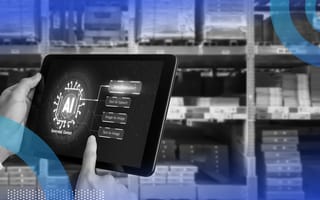Most companies have an environmental, health and safety (EHS) function, even if it goes by a different name. These specialists sit at the intersection of operations, compliance and worker well‑being. One day, they’re writing hazard‑communication plans to keep Occupational Safety and Health Administration (OSHA) happy; the next, they’re investigating a near‑miss in the warehouse, auditing chemicals for an ESG report or coordinating an evacuation drill at a refinery. Their mandate is simple but daunting: prevent injuries, protect the planet and keep production humming.
4 Features of an Effective Health and Safety AI Tool
- Data stewardship over data hoarding
- Human‑in‑the‑loop design
- Outcome obsession
- Trust, privacy and governance
AI headlines keep ballooning, but no one on a factory floor cares about algorithms. They care about getting every worker home in one piece and keeping the business off tomorrow’s disaster briefing. That’s why I have little patience for future‑of‑work AI think pieces that float above the trenches of health and safety. The future of AI in EHS is already running on tablets, sensors and drones, wearables and cameras in places where a missed risk means an ambulance ride.
Even as some workplaces struggle with the unintended risks of automation — warehouses that have become more dangerous under tech-driven productivity demands — research underscores that the real hazard isn’t automation itself, but failing to design systems that keep human judgment and accountability in the loop.That balance, human expertise supported by intelligent tools, is where AI is proving indispensable in EHS.
How AI Can Save Lives on the Front Line
The future of safety isn’t a decade away; it’s already embedded in tablets, sensors, drones, wearables and cameras in places where a missed risk can mean an ambulance ride.
Real‑world health and safety teams tell us what they need now, not in a decade. First on the list is scrapping rote paperwork. When AI can finish incident logs, inspection checklists, and travel‑health clearances in seconds, safety professionals gain back the hours they need to prevent the next accident rather than memorialize the last one.
They also want sharper foresight. Machine‑learning models can surface the “why” behind subtle anomalies long before they snowball into citations or casualties, giving leaders time to act. Frontline supervisors crave on‑demand expertise as well, which is why computer‑vision ergonomics that guide a single worker through a risk evaluation are earning fast adoption. Finally, teams insist that EHS software feels personal. AI that adapts dashboards, alerts, and workflows to each role delivers digestible, just‑in‑time guidance where a 100‑page manual would gather dust.
None of this replaces people. It replaces the friction that keeps good people from acting on their own know‑how. It helps prevent grave errors and saves lives across risky and dangerous industries.
Examples of AI at Work on Front Lines
Consider a mobile‑first workforce hub recently rolled out by a global logistics firm: any employee — driver, dock worker or supervisor can snap a hazard photo, trigger an incident workflow, and close the loop before the next shift starts, no desktop needed. At a European auto plant, a smartphone‑based motion‑capture app now turns a quick video of an operator’s posture into a full 3D ergonomic report in under ten minutes, cutting weeks off traditional assessments.
One multinational retailer has wired its existing CCTV network into an AI layer that flags missing PPE and unsafe forklift routes in real time, freeing safety staff from endless camera feeds. An energy conglomerate uses bowtie risk diagrams to map how a single valve failure could ripple into production losses, emissions spikes, and brand damage. This gives executives a clear line of sight to the controls that matter most.
Consider the United Nations High Commissioner for Refugees. Nearly half of its 15,000 employees deliver aid in conflict zones with no hospitals in sight. AI triage can track health status, predict travel‑readiness issues, and coordinate medical evacuations in minutes, not hours. That’s lives protected, not “worker productivity optimized.”
These are use cases that are in daily use. AI finally lets safety and health leaders aim higher. When a model spots a fatigue trend in 12‑hour shifts, you can redesign schedules before OSHA shows up. When integrated sustainability data links Scope 3 emissions to equipment failures, you solve two problems in one budget cycle. AI can turn compliance into a springboard for operational resilience and hard financial return.
Why AI Hype Kills Adoption
AI fails when it’s parachuted in as a shiny add‑on. But it works when it’s embedded in EHS workflows, built on clean data and scoped to problems people actually face. That demands four disciplines:
- Data stewardship over data hoarding. Dumping siloed spreadsheets into a model delivers garbage insights. Consolidate first, model second. You absolutely have to prioritize quality over quantity. Clean data equates to good outcomes.
- Human‑in‑the‑loop design. A predictive alert is useless if the supervisor can’t act on it within their existing process. Build the workflow around the user, not the algorithm. Human-centric AI is how every system should be designed. AI is the workflow accelerator but humans should always be the decision makers.
- Outcome obsession. Focus on measurable impact like hours saved, injuries avoided, emissions reduced. But start with the problem, not the technology. Let AI prove its value through iteration, learning, and adjustment. ROI can take time, often requiring fine-tuning, learning from missteps, and most importantly, working backwards from the problem.
- Trust, privacy, and governance. Data is an enterprise’s most valuable asset. AI must honor privacy protections, operate securely, and fit within organizational governance frameworks. Trustworthy AI can’t be an afterthought, it’s as critical as outcomes. If employees don’t believe their information is safe, adoption dies on the vine.
Environmental, health and safety professionals have always been quiet innovators. Now is the moment to demand technology that works as hard as they do. AI isn’t coming for their jobs. It’s coming for the parts of their jobs that drain their day and hide their impact. Let it.





